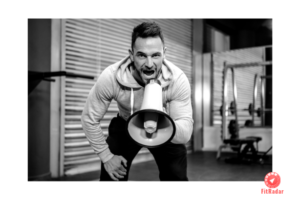
Sometimes it can feel nearly impossible to get yourself in shape, which is why personal trainers are so helpful. Not only do they give you that extra push, but you also get the benefits of their expert knowledge and experience. Even with their guidance, however, your efforts will be in vain if you aren’t following the right diet and fitness regimen for you. To find out exactly how you can improve your fitness routine, WD spoke with top-notch personal trainers for their secrets to getting the most out of your workout and living an overall healthier life.
1. Set realistic goals and be confident.
Before starting your path to a healthier lifestyle, it’s important to be realistic about how much time you have for the results you want, and how you can achieve them. Colleen Faltus, private trainer at The Sports Club/LA in Boston, suggests compiling “a list of both short- and long-term goals. This will keep you motivated to accomplish and surpass them; it will give you focus and add some variety to your workout.” Another trick to staying focused? Be confident! Trainer Bill Trimble, founder of the workout program Extreme Bill Trimble, says, “if you’re not confident and determined you can achieve your goals, you won’t. Make sure you try to stay positive and keep your head up, even on those rough days.”
2. Get specific about what you want to achieve.
Although you may think your trainer will automatically know what you want, that isn’t the case. Trimble says telling your trainer exactly what your goals are is the key to success. A weight-loss plan, for instance, will be different from a plan for someone trying to build muscle. Your trainer will design a routine based on your individual needs and lifestyle, so letting him or her know exactly what you want up front will help you get the most out of the experience.
3. Have fun!
“Working out should be enjoyable. Your personal trainer is there to push you a little bit, but not intimidate,” says Trimble. During your initial consultation, talk with your trainer about activities you enjoy, your schedule and exercises you don’t particularly like. This way, he or she can devise a routine you’ll love. Another key factor to having fun is variation. “Incorporating other elements of fitness besides cardio will increase the likelihood of faster and more efficient weight loss,” explains Faltus. Another plus? You’re less likely to become bored if you try new things.
4. Performing each exercise correctly is imperative, so watch your form.
To achieve the best possible results and stay injury-free, follow your trainer’s instructions about proper form. This is especially important if you’re doing an at-home workout on your own. “Model the video or demonstration exactly, paying special attention to the trainer’s breathing technique and form,” Trimble urges.
5. You should begin to see results within 12 weeks.
Depending on your workout plan, the three-month mark can be a good indicator of how you’re doing. “In about 90 days, you should be able to notice results—whether it be that your jeans are a little looser, your quality of sleep is better or you just feel good all around,” Trimble says. Many people lose motivation if they don’t see results sooner, but you’re changing your physique, so 12 weeks is about how long it will take before your workouts begin building lean muscle.
6. Communication is the key to success.
As with any relationship, communication is vital when it comes to a healthy and happy experience. Faltus recommends giving your trainer feedback about how you are or aren’t liking the exercises, what is or isn’t working and anything else that’s on your mind. Most often, your trainer will check in with you before and after the workout. So use the opportunity to talk! “You know your body better than anyone else, so speak up at each session and your experience will be that much more enjoyable and exciting,” Faltus says.
7. You’re going to have bad days.
“You’re going to fall off the wagon and have off days at some point,” says Trimble. “But get right back up and begin again without getting discouraged.” The biggest problem trainers see in their clients is that their emotional confidence starts to dwindle when something goes wrong. “You have to believe in yourself and [believe] you can do it,” Trimble says. So, if you splurge on your eating one weekend, don’t beat yourself up—just give it your all during your Monday workout session.
8. If you don’t have a trainer, you can still stay motivated.
On those mornings when you just can’t get yourself out of bed, it’d be pretty nice to have a trainer waiting for you at the gym. But you don’t need a trainer if you know how to find motivation elsewhere. For one thing, Trimble recommends working out with a partner for extra encouragement. He also suggests choosing a fun workout so you’ll look forward to it. “These days, so many programs are easily accessible, such as at-home boot camp workouts, circuit training, online videos and specific plans such as the P90X workout.” And perhaps most important, be consistent. If you exercise on the same days every week, not only can you schedule around your workout, but you’ll be more likely not to miss it.
9. You have to eat right, too.
Personal trainers aren’t miracle workers, so after you leave the gym, make sure you follow the diet plan you’ve established for yourself (or with the help of a dietician). One way Trimble helps his clients eat right is by encouraging them to keep a food journal. “Nutrition can be a problem, so writing it down and being able to look at it with my clients is helpful,” he says. Not only will you be able to discuss what you’re eating with your trainer, but you’ll also become more aware of your food choices—and rethink that second piece of cake! One way Faltus suggests you start a good nutrition plan? Let yourself cheat. “Eating balanced meals filled with fruits, vegetables, grains and protein will prove successful in the long run. But remember to give yourself a ‘cheat’ nutrition day on the weekends.”
10. You’re probably not getting enough sleep.
“Lack of sleep causes a decrease in energy and motivation to accomplish both short- and long-term goals.” Not only are proper sleeping habits important for you mentally, but if you don’t rest your muscles properly before and after a good workout, you risk injury. Faltus says to “adjust your sleep schedule and get both quality sleep and a decent quantity of sleep. You’ll notice the difference in your overall performance, and your muscles will thank you too.” For some tips on how you can destress and unwind before bed to sleep better, click here.
Source: https://bit.ly/35QuewC
Please visit our website and join the waiting list. Our app is coming soon: http://fitradar.me/

